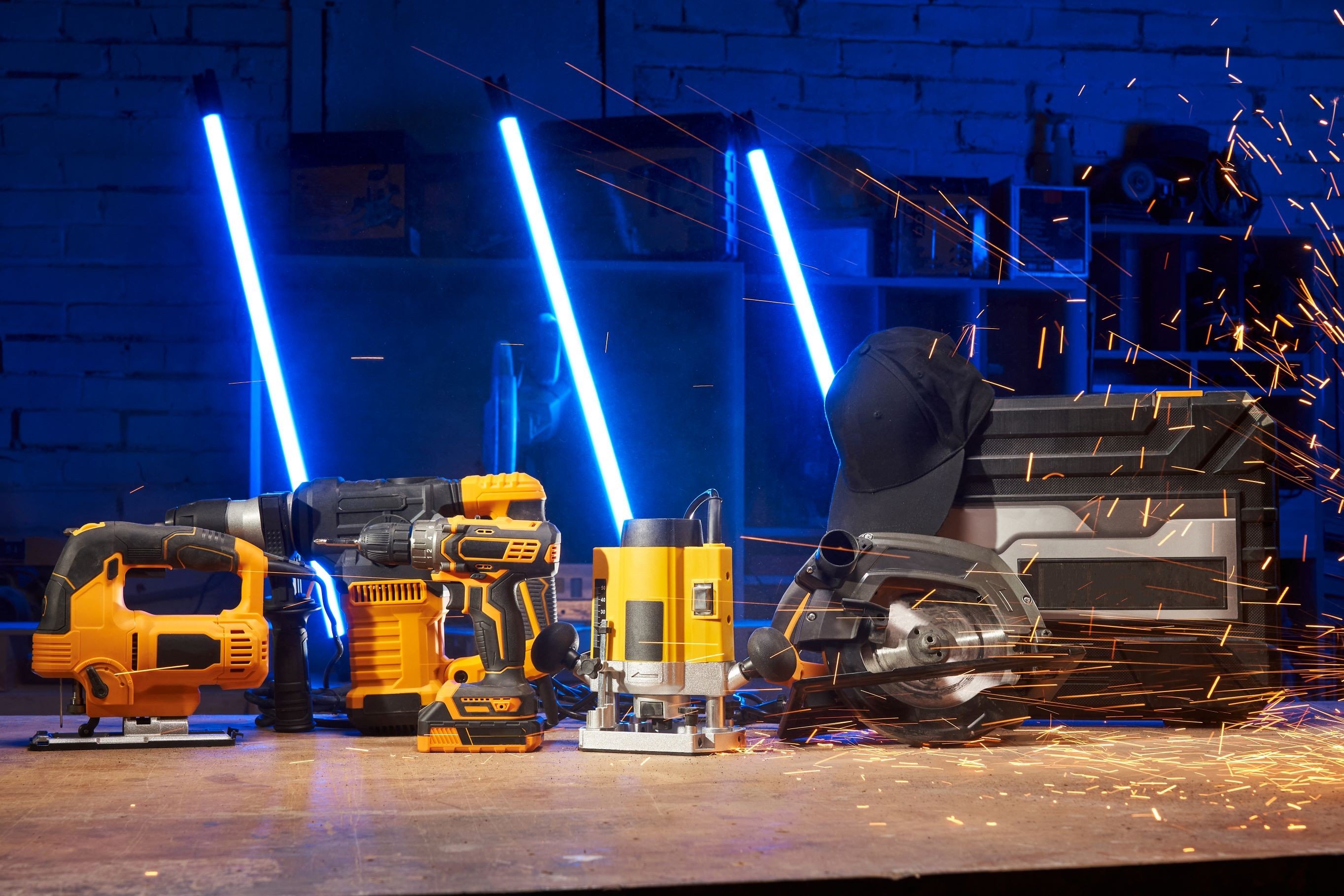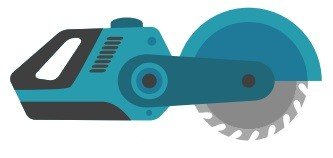10 Things We All Love About Shop Power Tools
페이지 정보

본문
 The Workhorse of the Shop power tools store Tools
The Workhorse of the Shop power tools store ToolsHand-held buy power tools tools are powered by electricity, internal combustion or compressed air. They can be used to cut, drill grind or sand materials.
One of the most important power tools every woodworker should own is a table saw, which makes quick work of nearly any cutting task. Also consider a miter saw stand and a drill/driver set.
Table Saw
Table saws are one of the most versatile tools in the shop. It can rip cross-cut, miter cut, and even dado and rabbet stock. It can also cut angled surfaces to make frames or chests. It can also make planters, chests, or frames.
The circular blade of the saw is large and is able to rotate at a high rate. It has tables of a decent size (infeed and outfeed) that help support the stock as it passes through the blade. The saw blade is protected by a blade guard that helps to keep the wood from getting caught and then possibly being kicked back at the operator. The saw is also protected by a splitter or riving blade. It is a vertical projection that is directly behind the blade, and may be shaped like pin or fin.
Contractor-style tablesaws are equipped with a bigger motor, that is hinged off the rear and drives the blade by using two or three rubber V-belts. They are typically used by carpenters but are also found in shops for home use. They have more features, including an adjustable mitertable that slides, and are more durable than portable ones.
Table saws that are smaller come with smaller motors that is usually driven by belt. They are less feature-packed and are targeted more towards homeowners and hobbyists. Many feature a sliding miter table which allows the user to cut intricate cuts, such as those for mirror and picture frames or drawers, boxes and cases.
It is important to use a tablesaw correctly in order to avoid injuries. Always stand to the left of the blade when making rip cuts and ensure that your hands are away from the saw's edge. When cutting, it is crucial to use a guide block or push stick. This is particularly true in commercial settings where HSE standards demand that you keep at least one hand distance from the blade.
Many woodworking projects call for tapered legs, and the simplest and fastest method of cutting them is using a table saw and a simple tapering jig you can make at home. A tapering jig is adjusted for any angle between 15 and 0 degrees, allowing you to cut any set of tapered legs to fit furniture like tables or cabinets in your shop.
Bandsaw
A bandsaw can be used to cut wood and metal into different shapes. It is a great tool for customizing fabrication. It's also a useful tool to make furniture, cabinetry and other woodworking projects. The saw is able to make curved cuts, including circles, and can cut through many types of materials, including ice.
There are two main types of bandsaws: the vertical and horizontal. Vertical bandsaws excel in resawing, curved cuts and freehand cutting. Horizontal bandsaws produce a more straight and angled cuts. The saw can be operated either manually or via powered feed systems. Manual bandsaws require the user to manually lower and raise the blade each time they cut. power tools cheap-fed systems are more efficient.
Safety is the most important factor when working with bandsaws. Wear protective gear such as safety goggles or ear protectors, to protect yourself from noise and sawdust. To avoid injuries and accidents keep your hands and feet clear of the blade. It is also important to set up the saw properly to ensure safe operation. Make sure that the blade and guides are aligned and that the blade is secured.
Depending on the kind of material you are cutting, you may have to adjust the feed rate and saw speed to get the most efficient results. Regular maintenance that includes adjustments to the tension and tracking of the blade will ensure that your saw makes precise and clean cuts and prolongs the life of its.
The blade on a bandsaw is usually constructed from high-quality steel that's been heat treated to withstand the strains and fatigue of frequent use. The teeth are also welded onto the saw, giving it its unique shape and preventing them from being pulled loose or damaged by a sudden jolt.
The throat depth of a bandsaw determines the size of a piece of wood it can cut. Larger throat depths can be used to cut larger pieces of lumber and are ideal to rip or resaw, both of which require cutting across grain. It's also worth noting that some bandsaws come with tilting tables, which can be useful for making certain types of angled cuts or recycling scrap wood.
Dust Collector
Woodworking tools produce a lot of dust and chips that must be collected to protect your health, your shop's cleanliness, and the longevity of your equipment. The type of collector you require is determined by the number and size of power tools store tools Close to me you use in your woodshop as in the frequency at which they are used. The top dust collectors for woodworking provide superior filtering capabilities that can remove fine particles from the air, allowing you to breathe cleaner, healthier and more comfortable while you work.
Nederman offers dust collection systems to meet your needs, whether you are a small-scale shop or a large-scale production woodworking facility. Our woodworking dust management, waste management and combustible-dust solutions blend environmental care with improvements in machine productivity.
There are several types of woodshop dust collectors on the market including:
A basic dust extractor can replace your shop vac. These devices connect to power tools using a hose that connects to the dust port on the machine. The hose is activated when you switch on the tool and it pulls dust and debris out of your workspace.
Depending on the model you select, the majority of dust extractors have HEPA filters to effectively remove dust particles which can cause respiratory problems over time. They also usually come with a higher CFM (cubic feet per minute) airflow, which allows for more air. They may also include an airspeed indicator and a system which automatically cleans the filters.
If you have a bigger shop or would like the added flexibility to work with your woodworking tools on the go, consider a portable woodshop dust collector with an energy-saving battery that can be recharged and an integrated plug-in connector that connects directly to the british power tools tool. These tools are lightweight and can be used with several tools at the same time. They are small and have a caster-base. They also include bags or a filter for collection to make it easy to empty.
If you are an experienced woodworker or contractor, you might require an even more robust dust collection system. These are more expensive than an extractor, but they offer a wider range of filtration options and can be hung on a wall or a separate room in your shop. These units can be used to clean drywall, plaster and other demolition tasks as well as woodworking projects.
Planer
The planer is a power tool that no woodshop should ever be without. It's not the most stunning or flashy tool, however it can make a huge difference in the way you transform rough lumber into beautiful and useful projects. It can be used to reduce boards to a specific thickness. It works on softwoods as well as hardwoods. It can also be very helpful for tackling knotty, unwieldy or twisty stock that is difficult to work with using hand tools.
A quality portable planer can easily be worth the cost of admission to any woodworking shop. You might be able find a planer at a great price, but pay attention to the condition and the table for outfeed and infeed. These elements will determine the level of performance your planer will perform and whether it will last a long time before needing replacement parts. If the cutter head on your planer is not of high quality it will deteriorate quickly and you may need to replace it within a short period of time.
Many people confuse the planer and the jointer, but they are not the same machines. The jointer makes a board flat and straight, while the plane cuts it to a certain thickness. Some woodworkers employ both machines at the same time to complete the task. But, they are equally essential for any workshop handling rough lumber on a regular basis.
 If you are looking to perform woodworking with a professional standard and you are looking for an equipment that is reliable that is commercial-grade, then a planer is a good investment. These machines are designed to work in situations where speed of production is more important than surface finish. These machines will save you a amount of time, however you must be careful not to overload them. They could be able to burn out. They should also be properly maintained to ensure that they are operating properly. A regular maintenance program for your shop will go a long way in extending the life of your planer.
If you are looking to perform woodworking with a professional standard and you are looking for an equipment that is reliable that is commercial-grade, then a planer is a good investment. These machines are designed to work in situations where speed of production is more important than surface finish. These machines will save you a amount of time, however you must be careful not to overload them. They could be able to burn out. They should also be properly maintained to ensure that they are operating properly. A regular maintenance program for your shop will go a long way in extending the life of your planer.- 이전글5 Robot Vacuum Cleaner For Sale Projects For Any Budget 24.12.16
- 다음글20 Amazing Quotes About Compact Pushchair 24.12.16
댓글목록
등록된 댓글이 없습니다.